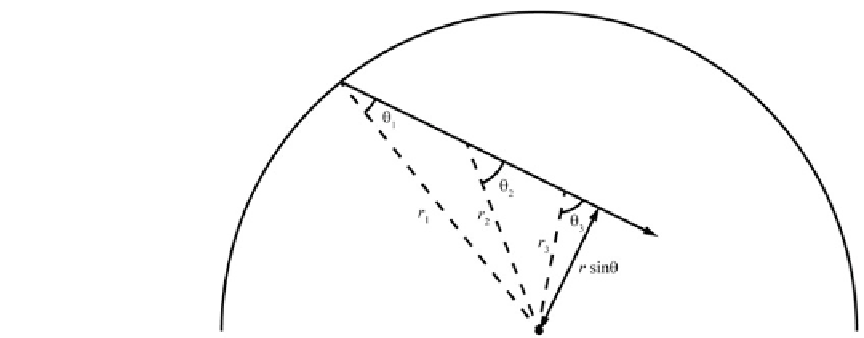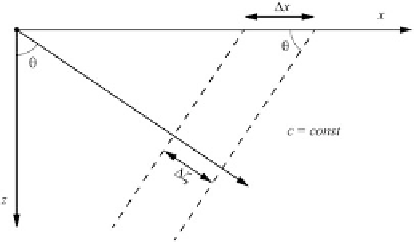Geology Reference
In-Depth Information
Fig. 9.5
In a spherical
homogeneous Earth,
seismic rays are straight
lines but the incidence
angle changes with depth.
In this instance, the
quantity
r
sin™(
r
)is
invariant
only upon the distance
r
from the Earth's center,
so that
s
D
s
(
r
)and™
D
™(
r
). In this instance, the
vector invariant assumes the form:
p
D
r
s.r/
d
d—
(9.41)
Also in this case the seismic rays lie on vertical
planes, and it is easy to prove that Snell's law
assumes the form:
Fig. 9.6
A downward propagating plane wave from a
seismic source at the Earth's surface. The material is
homogeneous, so that the seismic rays are straight lines
and the incidence angle ™ is constant
p
D
s.r/r sin ™.r/
(9.42)
In fact, in this instance sin™ is not anymore
invariant when the slowness is constant (Fig.
9.5
).
Conversely, the example of Fig.
9.5
shows that in
the spherical context the quantity
r
sin™ will be
conserved for
s
(
r
)
D
const
. It is important to note
that both the flat approximation (
9.40
)andthe
spherical conservation law (
9.42
) do not take into
account of
lateral inhomogeneities
, so that they
are only applicable when the seismic velocity
depends from a unique parameter (
z
or
r
).
T
s
D
x sin ™
—
D
(9.43)
Therefore, by Snell's law:
T
x
D
s sin ™
D
p
(9.44)
This relation implies that a measurement of
arrival times at different seismic stations allows to
determine the seismic parameter
p
. It also implies
that
p
is the
apparent
slowness of the wavefront
in the horizontal direction. Therefore,
p
is some-
times referred to as the
horizontal slowness
of the
seismic ray. Let us assume now that the wave
strikes a horizontal discontinuity in the elastic
parameters, so that we can separate the material
into an upper layer with velocity
c
1
and a lower
layer with higher velocity
c
2
>
c
1
(Fig.
9.7
).
For
s
2
<
s
1
, Snell's law predicts an
increase
9.4
1-D Velocity Models
Let us consider now a plane wave that propagates
through a homogeneous material with constant
slowness
s
(Fig.
9.6
). The wavefronts at time
T
and
T
C
T
are separated by a distance —
along a seismic ray. At the Earth's surface, the
wavefront arrivals have a different separation
x
,
which depends from both — and the slowness
s
:



